Tetris 99 is a weird game. Sure, it’s that version of Tetris that Nintendo Switch Online subscribers can download for free, but beyond that, it’s also a battle royale game. Unlike the delightful mashup that is Puyo Puyo Tetris or the meditative bliss that is Tetris Effect, Tetris 99 is all about competition. Learning Tetris 99 is usually a process of trial and error, with you trying to clear lines as 99 other Tetris boards shoot unfinished lines your way. To take the guesswork out of the game, we’ve put together a guide on the best Tetris 99 tips and tricks so you can get started on the right path.
Further reading
- The best Nintendo Switch games
- The best indie games on Nintendo Switch
- The best multiplayer games on Nintendo Switch
Tetris tips and tricks, how to play
Tetris 99 doesn’t come with a tutorial, and even for seasoned tetromino builders, it’s not necessarily super easy to understand how it all works. From how to win to sending garbage to other players, our guide will teach you the ins and outs of this different type of battle royale experience.
Tetris 99 explained

Tetris 99 is largely the same as any other Tetris game. The goal is to arrange the seven different tetrominoes as they fall into the screen to clear lines, preferably multiple lines at once. As you clear lines, you’ll send garbage (the gray blocks) to other players’ screens. In short, the goal is to not let your board fill completely. If you manage to keep it in playable condition longer than the rest of the competition, you win. Sounds easy enough, right? Unfortunately, it’s more complicated than that. Winning takes both expert Tetris skills, a little bit of luck, and a command of Tetris 99‘s various new mechanics.
How to send garbage
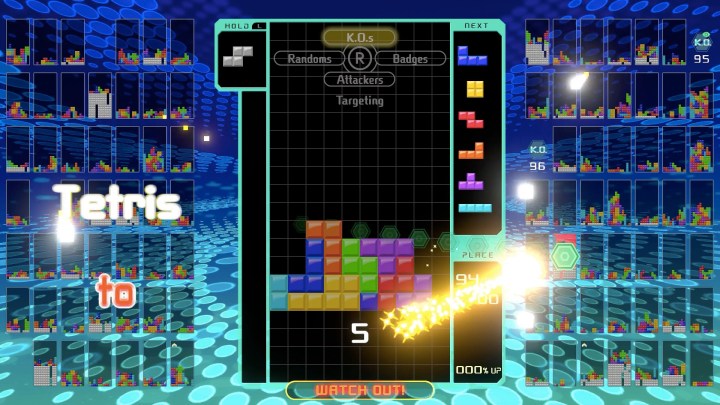
Before we talk about new mechanics in Tetris 99, let’s discuss garbage. As previously mentioned, garbage is your form of attack in Tetris 99. It’s a well-known feature in multiplayer Tetris. At the start of a game, you can send garbage by clearing more than one line with a single move.
- Clear two lines: Send one garbage line
- Clear three lines: Send two garbage lines
- Tetris (clear four lines): Send four garbage lines
- Full clear (the board is empty): Send 10 garbage lines
You can also send garbage lines by successfully clearing rows with T-spins, an advanced Tetris move that requires the T block. In order to perform a T-spin, you must create a T-shaped gap in your structure. When the T block enters it, the last move you perform must be a turn. Simply dropping a T block into a spot will not trigger a T-spin. T-spins reward more garbage lines than regular clears.
- T-spin single: Send two garbage lines
- T-spin double: Send four garbage lines
- T-spin triple: Send six garbage lines
Targeting other players
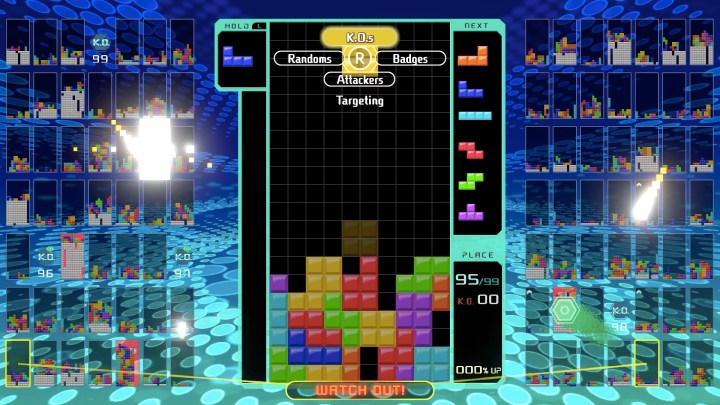
Tetris 99‘s twist comes with its targeting options — Random, Attacker, Badges, and K.O.s. These options are shown in the upper center of the screen, and you can choose between them using the right stick. One of the more popular choices for targeting other players is the K.O. option, as it hones in on your opponents that are close to losing. We’ll explain what all the targeting options do in more detail below.
Additionally, you can manually target certain players by using the left stick. Selecting specific players can give you the upper hand if you target weak opponents with messy stacks that the auto selection tool hasn’t picked up on yet. You can also focus on dropping garbage on players you find to be a threat.
Random

Random is the default targeting setting and it’s exactly as it sounds. If you simply do not care to worry about where you send your garbage, Random will choose a destination for you. It’s usually fine to keep it on Random for the first minute or so, but you’ll definitely want to make use of the other three more in-depth options as the round carries on.
Attackers

In Tetris 99, you’ll know who is attacking you based on the yellow lines extending onto your screen. Sometimes it’s no one, other times it’s one or two players, and if you’re really unlucky, you can have half a dozen or more players flinging garbage at you at once.
The Attackers targeting option sends your garbage to those who are trying to take you out. Critically, you’ll send garbage for your clears to all of the players attacking you. It doesn’t split it up or anything like that. So while it’s hard to overcome a bunch of attackers, if you get on a roll, you can knock out several players in quick succession.
K.O.s
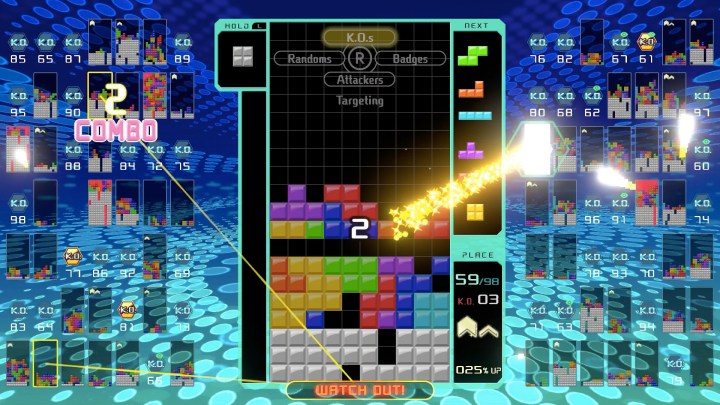
As we mentioned earlier, the K.O. option strategically targets players who are close to being knocked out. You can take a glance at both sides of your grid to see when players are struggling, but generally aiming for K.O.s by default is a great idea. Especially in the early goings when there are still a ton of less-skilled players in the field.
Badges

Badges is the option that’s the least understood. If you choose to target Badges, just know that things may get tough in a hurry. Badges targets players with the highest knockout counts. There’s a good reason to target Badges, though. If you take out a leading player, their knockouts go toward your garbage bonus. Speaking of which …
Percentage up garbage bonus
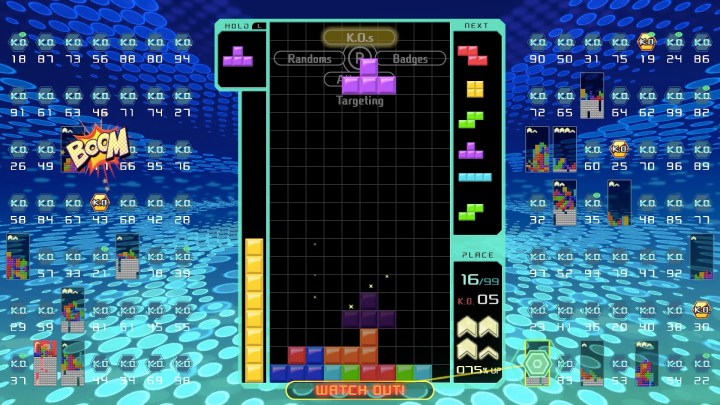
In the lower right-hand corner of your grid, you’ll see a K.O. counter and a percentage up figure. The percentage up bonus allows you to send more garbage with each clear. Knockouts go toward filling your percentage up bonus, with each bonus representing a badge.
- 25% bonus: 2 knockouts
- 50% bonus: 6 knockouts
- 75% bonus: 14 knockouts
- 100% bonus: 30 knockouts
Getting the 25% or 50% bonus isn’t too hard if you make it past the midway point in the round, but the 75% and 100% bonuses are pretty daunting.
However, you also get the badges of the players you knock out, which makes Badge targeting so appealing. You won’t actually need to knock out 14 players to get a 75% bonus, and you definitely won’t need to knock out 30 to get the 100% bonus.
In fact, we’ve reached the 100% bonus without ever even getting to the 14 knockout threshold. Once you knock out another player, you’ll see their bonus funnel into yours. Sometimes you’ll watch as your 25% bonus transforms to 75% in an instant.
How to cancel out attacks

Each time garbage is sent your way, you can see it pile into a column just outside of your grid. At first, it’s gray, then yellow, then red. These colors signal how quickly you need to act before that garbage becomes a reality on your screen.
You can cancel out some or all of the garbage by clearing lines during this waiting period. It’s very important to pay attention to how much garbage is coming your way because if it’s a lot, it could bury you for good. Instead of worrying about setting yourself up for your next Tetris, you may need to make a series of quicker moves to keep the incoming garbage under control.
Preparing for speed increases
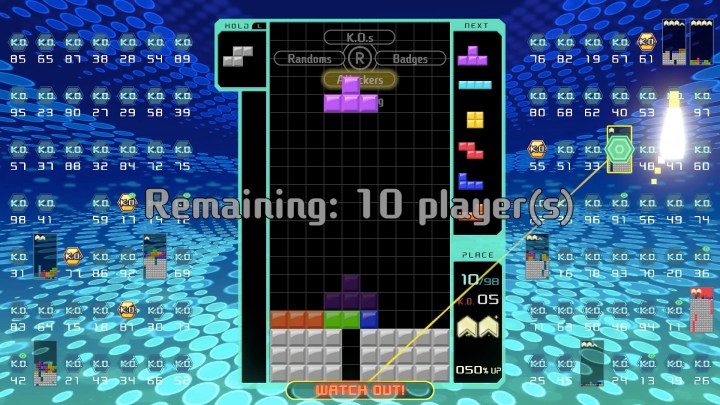
In battle royale shooters, the playable area shrinks over time. In Tetris 99, the speed increases. When you reach the top 50, the music picks up the pace along with the speed at which the blocks fall. This accelerated pace steps up the tension so you’ll want to look ahead at all the queued shapes coming your way to ensure you can fit them in to eliminate lines.
When you reach the top 10, the blocks fall at virtually the hard-drop pace. Unless you’re exceptionally good at keeping one eye on what’s coming next, you might have to depend on your reflexes or just plain luck to get through these stages.
Use the hold function and hard drops

One nice shortcut during these intense stages is being able to switch out the tetromino you have for something else. Hold it by pressing L on the Joy-Con or Pro controller to save that block for later.
This comes in handy particularly with the straight line tetromino (for setting up a Tetris) and the T block (for setting up T-spins).
Also, if you press up on the D-pad, you can hard-drop a tetromino into place, allowing you to move and clear-out lines much quicker.


